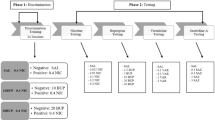Abstract
Previous studies have suggested that in some circumstances, learning processes such as overshadowing may determine the effects that one drug has upon the response to another. The experiments described here examined overshadowing in rats trained to discriminate mixtures of nicotine plus midazolam in two-lever operant procedures with food reinforcement. After training for 60 sessions, midazolam (0.32 mg/kg SC) overshadowed nicotine (0.32 mg/kg SC) so that the discriminative stimulus effect of nicotine seen in control rats trained with nicotine alone was abolished (n=8–10). In the next phase of the study, the discriminative response to midazolam in one group of mixture-trained rats was devalued by means of an extinction procedure which weakened the relationship between administration of midazolam and the response that was reinforced. Dose-response determinations then showed that the devaluation procedure had indeed attenuated the response to midazolam, whereas the previously overshadowed response to nicotine was restored. Post-session injections of drugs were used to equate the pharmacological histories of the groups and the effects seen were therefore attributable to training with the drugs and not simply to repeated exposure to them. Additionally, in the control rats trained with nicotine only (with midazolam given post-session), midazolam markedly reduced response rates, whereas in the three groups of rats trained with the mixture, midazolam had little response rate-depressant effect; this observation suggests that behaviourally contingent tolerance had developed to the response rate-reducing effect of midazolam. Application of devaluation procedures in studies of the discriminative stimulus effects of single drugs with multiple effects may provide a means for manipulating the characteristics of the discriminations obtained and for identifying individual elements of the drug-produced stimulus complex.
Similar content being viewed by others
References
Colpaert FC, Niemegeers CJE, Janssen PAJ (1976) Theoretical and methodological considerations on drug discrimination learning. Psychopharmacologia 46:169–177
Colpaert FC, Niemegeers CJE, Janssen PAJ (1980) Factors regulating drug cue sensitivity: limits of discriminability and the role of a progressively decreasing training dose in fentanyl-saline discrimination. J Pharmacol Exp Ther 212:474–480
De Vry J, Slangen JL (1986) Effects of chlordiazepoxide training dose on the mixed agonist-antagonist properties of benzodiazepine receptor antagonist Ro 15-1788, in a drug discrimination procedure. Psychopharmacology 88:177–183
Dickinson A (1980) Contemporary animal learning theory. Cambridge University Press, Cambridge
File SE (1985) Tolerance to the behavioral actions of benzodiazepines. Neurosci Biobehav Rev 9:113–121
Gauvin DV, Young AM (1989) Evidence for perceptual masking of the discriminative morphine stimulus. Psychopharmacology 98:212–221
Gauvin DV, Peirce JM, Holloway FA (1994) Perceptual masking of the chlordiazepoxide discriminative cue by both caffeine and buspirone. Pharmacol Biochem Behav 47:153–159
Grant KA, Colombo G (1993) Discriminative stimulus effects of ethanol: effect of training dose on the substitution ofN-methyl-D-aspartate antagonists. J Pharmacol Exp Ther 264:1241–1247
Griffiths JW, Goudie AJ (1987) Analysis of the role of behavioural factors in the development of tolerance to the benzodiazepine midazolam. Neuropharmacology 26:201–209
Holohean AM, White FJ, Appel JB (1982) Dopaminergic and serotonergic mediation of the discriminable effects of ergot alkaloids. Eur J Pharmacol 81:595–602
Holtzman SG (1985) Drug discrimination studies. Drug Alcohol Depend 14:263–282
Järbe TUC, Hiltunen AJ, Swedberg MDB (1989) Compound drug discrimination learning. Drug Dev Res 16:111–122
Järbe TUC, Rijnders HJ, Slangen JL (1993) Random reinforcement selectively deteriorates drug discriminative stimulus control in rats. In: Harris L (ed) Problems of drug dependence, 1992. NIDA Monograph 132. National Institute on Drug Abuse, Rockville, MD. p 256
Kamin LJ (1969) Predictability, surprise, attention and conditioning. In: Campbell BA, Church RM (eds) Punishment and aversive behavior. Appleton-Century-Crofts, New York, pp 279–296
Kaufman MA, Bolles RC (1981) A nonassociative aspect of overshadowing. Bull Psychon Soc 18:318–320
Mackintosh NJ (1974) The psychology of animal learning. Academic Press, New York
Mackintosh NJ, Reese B (1979) One-trial overshadowing. Q J Exp Psychol 31:519–526
Mariathasan EA, Stolerman IP (1993a) Overshadowing of nicotine discrimination in rats: a model for behavioural mechanisms of drug interactions? Behav Pharmacol 4:209–215
Mariathasan EA, Stolerman IP (1993b) Discrimination of agonist-antagonist mixtures: experiments with nicotine plus mecamylamine. Behav Pharmacol 4:555–561
Matzel LD, Shuster K, Miller RR (1987) Covariation in conditioned response strength between stimuli trained in compound. Anim Learn Behav 15:439–447
Miles CG, Jenkins HM (1973) Overshadowing in operant conditioning as a function of discriminability. Learn Motiv 4:11–27
Pratt JA, Stolerman IP, Garcha HS, Giardini V, Feyerabend C (1983) Discriminative stimulus properties of nicotine: further evidence for mediation at a cholinergic receptor. Psychopharmacology 81:54–60
Rijnders HJ, Järbe TUC, Slangen JL (1990) Extinction and reacquisition of differential responding in rats trained to discriminate between chlordiazepoxide and saline. Psychopharmacology 102:404–410
Rijnders HJ, Järbe TUC, Slangen JL (1993) In a low-versus high-dose drug discrimination task, random reinforcement in one drug state alters discriminative control only in that state. Behav Pharmacol 4:37–45
Stolerman IP, Garcha HS, Pratt JA, Kumar R (1984) Role of training dose in discrimination of nicotine and related compounds by rats. Psychopharmacology 84:413–419
Stolerman IP, Mariathasan EA, Garcha HS (1991) Discriminative stimulus effects of drug mixtures in rats. In: Glennon RA, Jarbe TUC, Frankenheim J (eds) Drug discrimination: applications to drug abuse research. NIDA Monograph 116, National Institute on Drug Abuse, Rockville, MD pp 277–306
Stolerman IP, Pratt JA, Garcha HS, Giardini V, Kumar R (1983) Nicotine cue in rats analysed with drugs acting on cholinergic and 5-hydroxytryptamine mechanisms. Neuropharmacology 22:1029–1037
Stolerman IP, Rauch RJ, Norris EA (1987) Discriminative stimulus effects of a nicotine-midazolam mixture in rats. Psychopharmacology 93:250–256
White J-AW, Stolerman IP (1994a) Psychological blocking of drug discrimination in rats. Behav Pharmacol 5, [Suppl. 1]:111
White J-AW, Stolerman IP (1994b) Overshadowing and its reversal in a drug mixture discrimination. J Psychopharmacol 8, [Suppl.] A39
Wolgin DL (1989) The role of instrumental learning in behavioral tolerance to drugs. In: Goudie AJ, Emmett-Oglesby MW (eds) Psychoactive drugs: tolerance and sensitization. Humana Press, Clifton, New Jersey, pp 17–114
Author information
Authors and Affiliations
Rights and permissions
About this article
Cite this article
White, J.A.W., Stolerman, I.P. Reversal of overshadowing in a drug mixture discrimination in rats. Psychopharmacology 123, 46–54 (1996). https://doi.org/10.1007/BF02246280
Received:
Revised:
Issue Date:
DOI: https://doi.org/10.1007/BF02246280




